Evaluating Elevation Change Thresholds between Structure-from-Motion DEMs Derived from Historical Aerial Photos and 3DEP LiDAR Data
Abstract
1. Introduction
2. Study Area
3. Data
3.1. Reference Elevation from LiDAR
3.2. Historical Aerial Stereo Image Processing
4. Methods
4.1. DSM Development and Accuracy Assessment
4.2. Topographic Change Detection: Thresholding the DEM of Difference
5. Results
5.1. Resolution and Accuracy of DSMs Produced from Historical Aerial Imagery
5.2. Topographic Change Detection and Thresholding
6. Conclusions
Supplementary Materials
Author Contributions
Funding
Acknowledgments
Conflicts of Interest
Disclaimer
References
- Brown, E.H.; Atkinson, B.W.; Wolf, P.O.; Rodda, J.C.; Collins, M.P.; Penning-Rowsell, E.C.; Lee, D.O.; Brunsden, D.; Hollis, G.E.; Francis, M.; et al. Physical Problems of the Urban Environment: A Symposium: Discussion. Geogr. J. 1976, 142, 72. [Google Scholar] [CrossRef]
- Lee, E.M. Geomorphological mapping. Geol. Soc. Lond. Eng. Geol. Spéc. Publ. 2001, 18, 53–56. [Google Scholar] [CrossRef]
- Lóczy, D.; Sütő, L. Human Activity and Geomorphology. In The SAGE Handbook of Geomorphology; SAGE Publications: London, UK, 2012; pp. 260–278. [Google Scholar]
- Faccini, F.; Robbiano, A.; Roccati, A.; Angelini, S. Engineering geological map of the Chiavari city area (Liguria, Italy). J. Maps 2012, 8, 41–47. [Google Scholar] [CrossRef]
- Del Monte, M.; D’Orefice, M.; Luberti, G.M.; Marini, R.; Pica, A.; Vergari, F. Geomorphological classification of urban landscapes: The case study of Rome (Italy). J. Maps 2016, 12, 178–189. [Google Scholar] [CrossRef]
- Brandolini, P.; Faccini, F.; Paliaga, G.; Piana, P. Urban Geomorphology in Coastal Environment: Man-Made Morphological Changes in a Seaside Tourist Resort (Rapallo, Eastern Liguria, Italy). Quaest. Geogr. 2017, 36, 97–110. [Google Scholar] [CrossRef]
- Chirico, P.G.; Bergstresser, S.E.; DeWitt, J.D.; Alessi, M.A. Geomorphological mapping and anthropogenic landform change in an urbanizing watershed using structure-from-motion photogrammetry and geospatial modeling techniques. J. Maps 2020, 1–12. [Google Scholar] [CrossRef]
- Gesch, D.B.; Maune, D. The national elevation dataset. In Digital Elevation Model Technologies and Applications: The DEM Users Manual; American Society for Photogrammetry and Remote Sensing: Bethesda: Rockville, MD, USA, 2007; pp. 99–118. [Google Scholar]
- Heidemann, H.K. Lidar base specification. In Techniques and Methods; US Geological Survey: Reston, VA, USA, 2012; p. 4. [Google Scholar]
- James, L.A.; Hodgson, M.E.; Ghoshal, S.; Latiolais, M.M.; James, A. Geomorphic change detection using historic maps and DEM differencing: The temporal dimension of geospatial analysis. Geomorphology 2012, 137, 181–198. [Google Scholar] [CrossRef]
- DeWitt, J.D.; Warner, T.; Conley, J. Comparison of DEMS derived from USGS DLG, SRTM, a statewide photogrammetry program, ASTER GDEM and LiDAR: Implications for change detection. GIScience Remote. Sens. 2015, 52, 179–197. [Google Scholar] [CrossRef]
- Smith, M.J.; Keesstra, S.; Rose, J. Use of legacy data in geomorphological research. GeoResJ 2015, 6, 74–80. [Google Scholar] [CrossRef][Green Version]
- Westoby, M.; Brasington, J.; Glasser, N.F.; Hambrey, M.; Reynolds, J. ‘Structure-from-Motion’ photogrammetry: A low-cost, effective tool for geoscience applications. Geomorphology 2012, 179, 300–314. [Google Scholar] [CrossRef]
- Fonstad, M.A.; Dietrich, J.; Courville, B.C.; Jensen, J.L.; Carbonneau, P.E. Topographic structure from motion: A new development in photogrammetric measurement. Earth Surf. Process. Landforms 2013, 38, 421–430. [Google Scholar] [CrossRef]
- Gomez, C.; Hayakawa, Y.; Obanawa, H. A study of Japanese landscapes using structure from motion derived DSMs and DEMs based on historical aerial photographs: New opportunities for vegetation monitoring and diachronic geomorphology. Geomorphology 2015, 242, 11–20. [Google Scholar] [CrossRef]
- USGS EROS Customer Services USGS EROS Archive-Aerial Photography-Aerial Photo Single Frames. Available online: https://doi.org/10.5066/F7610XKM (accessed on 18 March 2020).
- Lowe, D. Object recognition from local scale-invariant features. In Proceedings of the Seventh IEEE International Conference on Computer Vision, Kerkyra, Greece, 20–27 September 1999; Volume 2, p. 1150. [Google Scholar]
- Snavely, N.; Seitz, S.M.; Szeliski, R. Modeling the World from Internet Photo Collections. Int. J. Comput. Vis. 2007, 80, 189–210. [Google Scholar] [CrossRef]
- Burrough, P.A.; McDonnell, R.A. Creating continuous surfaces from point data. In Principles of Geographic Information Systems; Oxford University Press: Oxford, UK, 1998. [Google Scholar]
- Lane, S.N.; Westaway, R.M.; Hicks, D.M. Estimation of erosion and deposition volumes in a large, gravel-bed, braided river using synoptic remote sensing. Earth Surf. Process. Landf. 2003, 28, 249–271. [Google Scholar] [CrossRef]
- DeWitt, J.D.; Warner, T.A.; Chirico, P.G.; Bergstresser, S.E. Creating high-resolution bare-earth digital elevation models (DEMs) from stereo imagery in an area of densely vegetated deciduous forest using combinations of procedures designed for lidar point cloud filtering. GIScience Remote. Sens. 2017, 54, 1–21. [Google Scholar] [CrossRef]
- Etzelmüller, B. On the Quantification of Surface Changes using Grid-based Digital Elevation Models (DEMs). Trans. GIS 2000, 4, 129–143. [Google Scholar] [CrossRef]
- Wheaton, J.; Brasington, J.; Darby, S.E.; Sear, D.A. Accounting for uncertainty in DEMs from repeat topographic surveys: Improved sediment budgets. Earth Surf. Process. Landf. 2009, 35, 136–156. [Google Scholar] [CrossRef]
- Taylor, J. An Introduction to Error Analysis: The Study of Uncertainties in Physical Measurements; Physics-chemistry-engineering, University Science Books: Sausalito, CA, USA, 1997. [Google Scholar]
- Chandler, J. Technical Communication: Effective application of automated digital photogrammetry for geomorphological research. Earth 1999, 24, 51–63. [Google Scholar]
- Lane, S.N.; James, T.; Crowell, M.D. Application of Digital Photogrammetry to Complex Topography for Geomorphological Research. Photogramm. Rec. 2000, 16, 793–821. [Google Scholar] [CrossRef]
- Williams, R. DEMs of difference. Geomorphol. Tech. 2012, 2, 1–17. [Google Scholar]
- Salach, A. SAPC–application for adapting scanned analogue photographs to use them in structure from motion technology. Int. Arch. Photogramm. Remote Sens. Spatial Inf. Sci. 2017, XLII-1/W1, 197–204. [Google Scholar] [CrossRef]
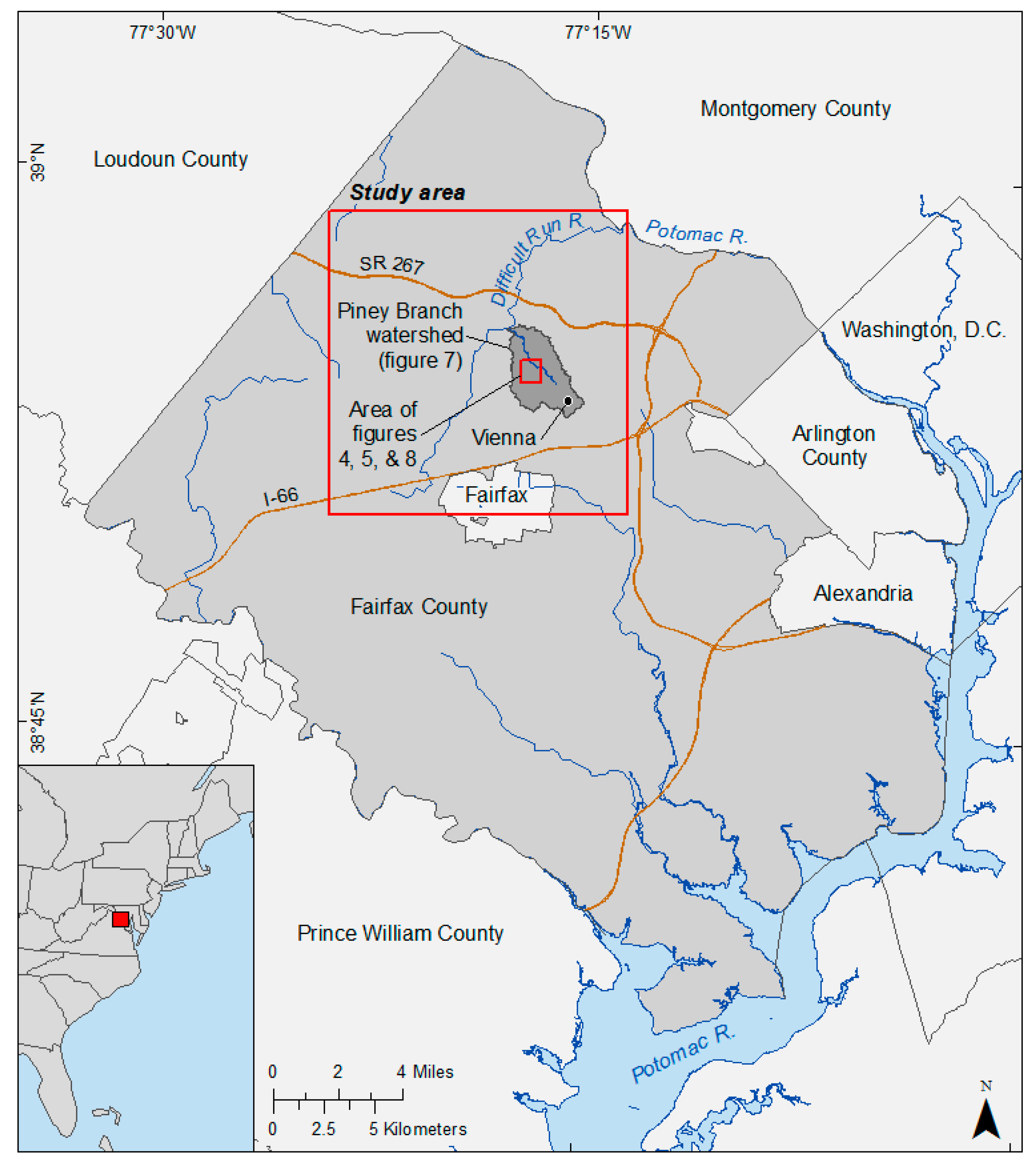
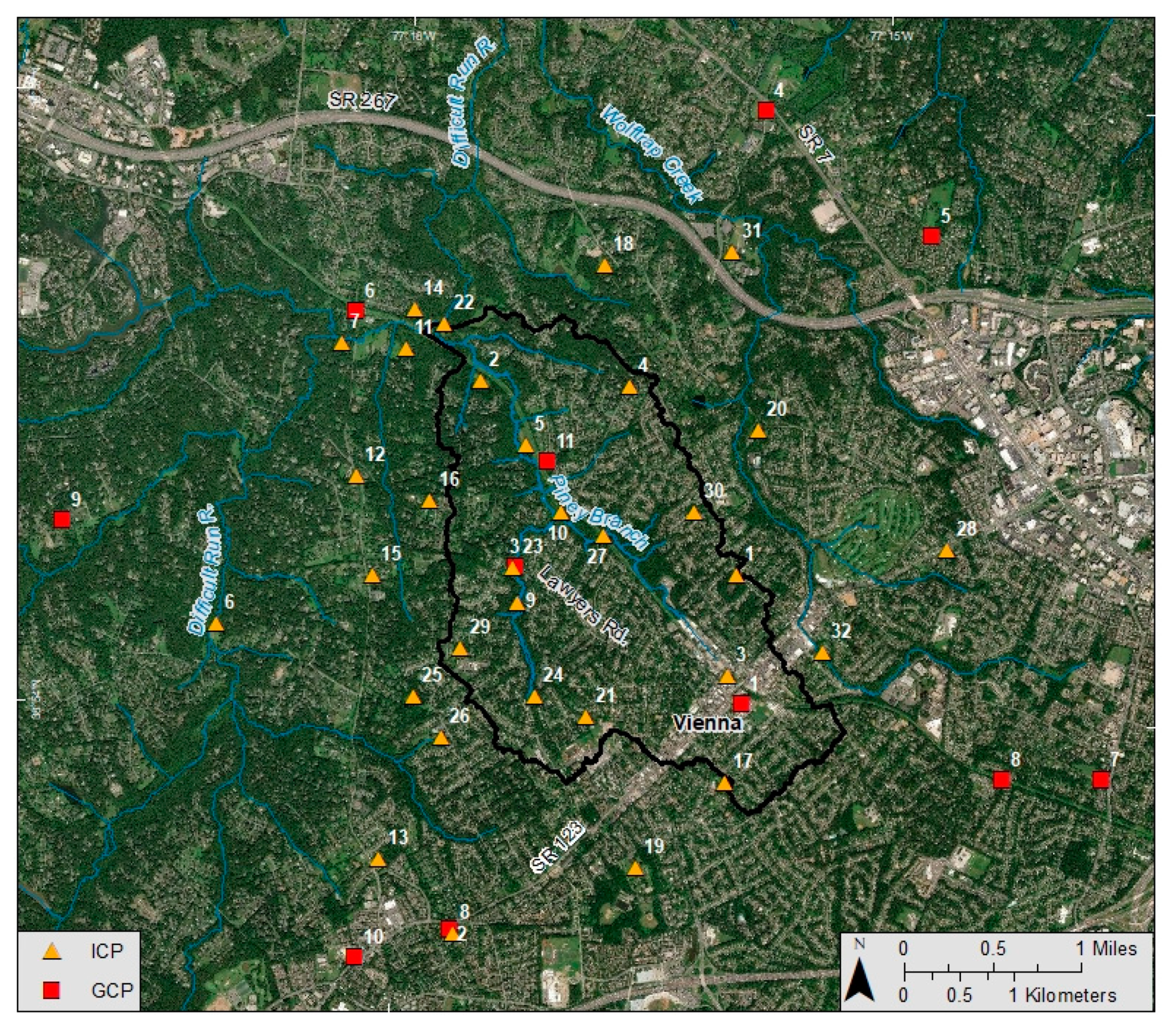
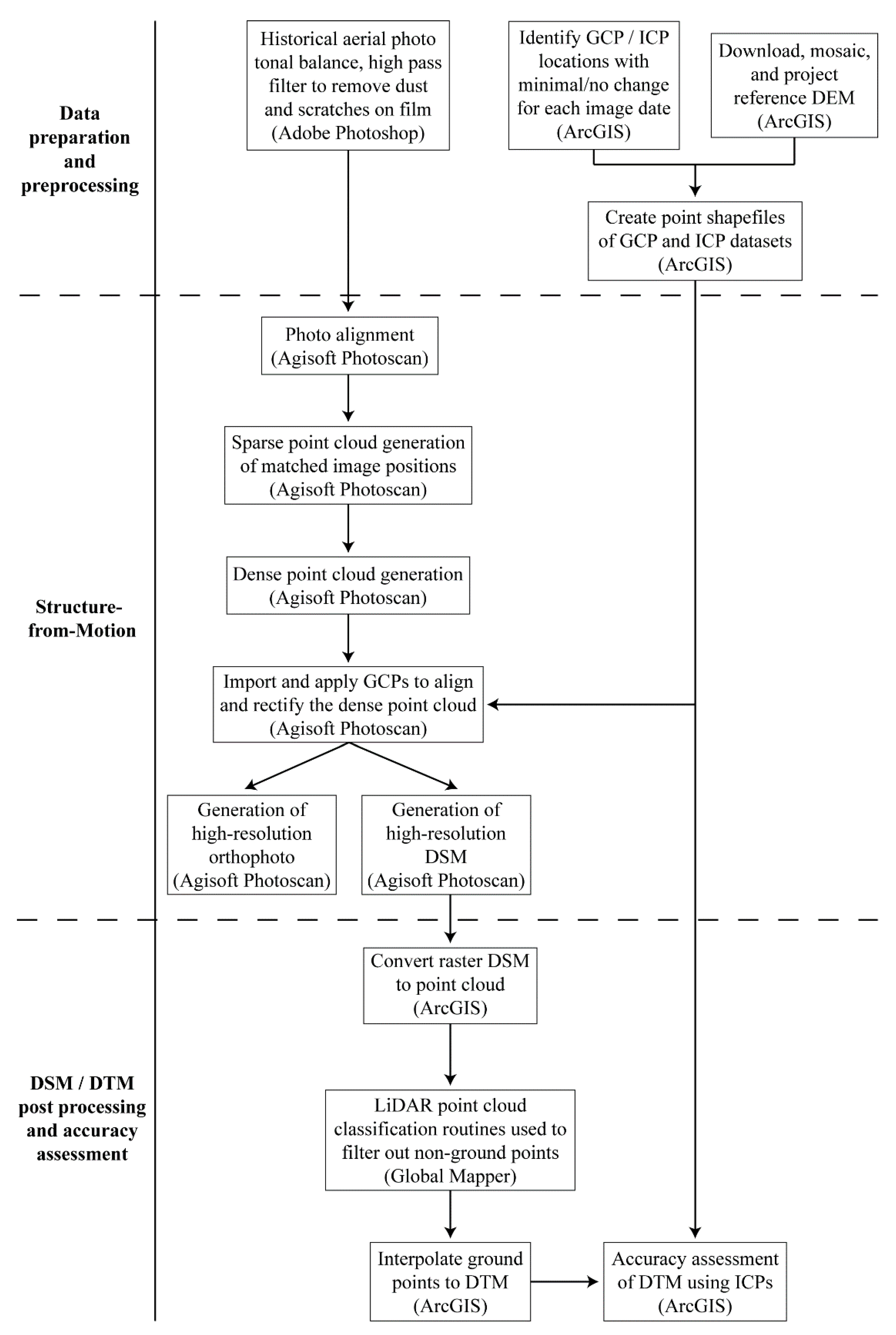
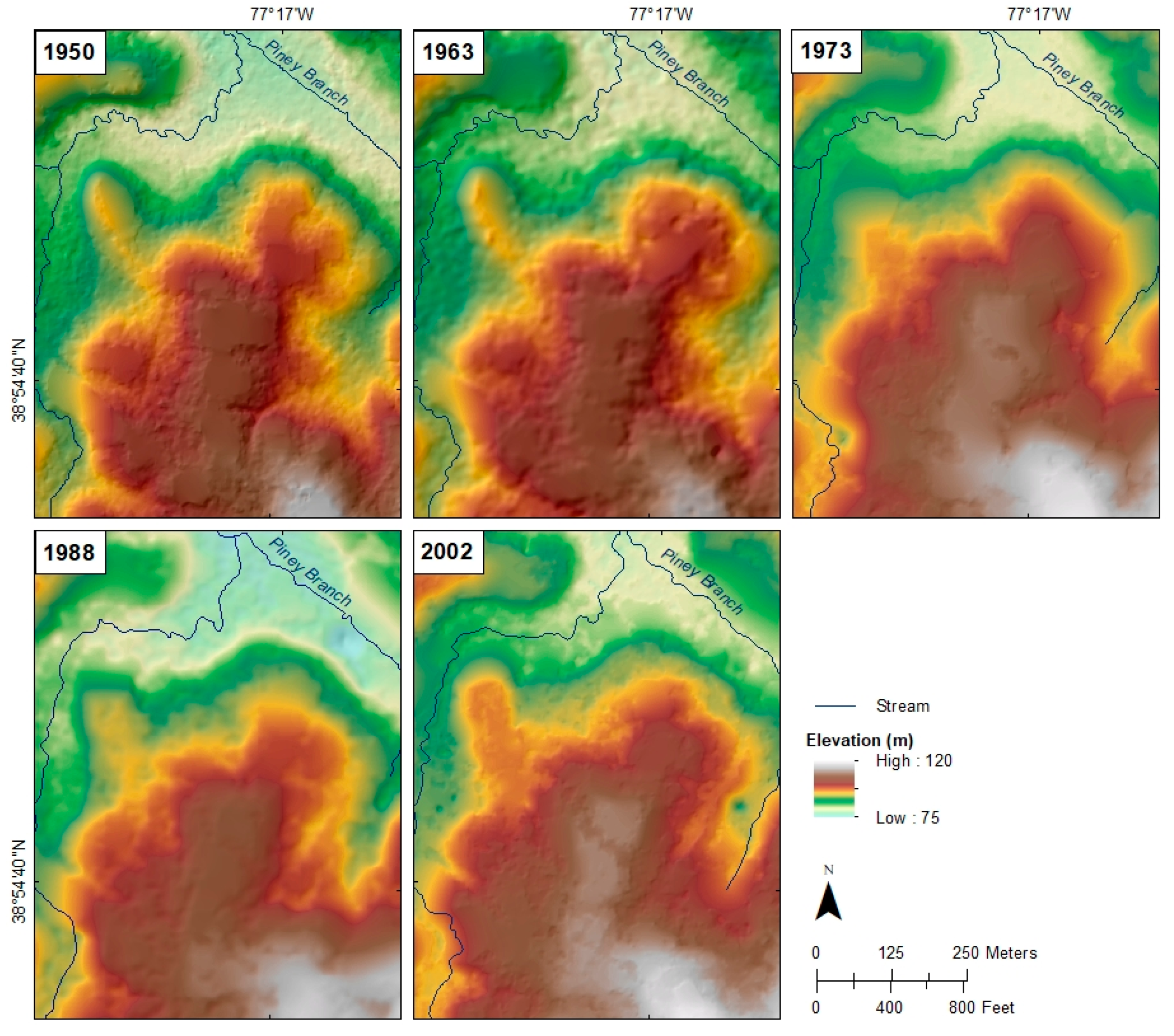
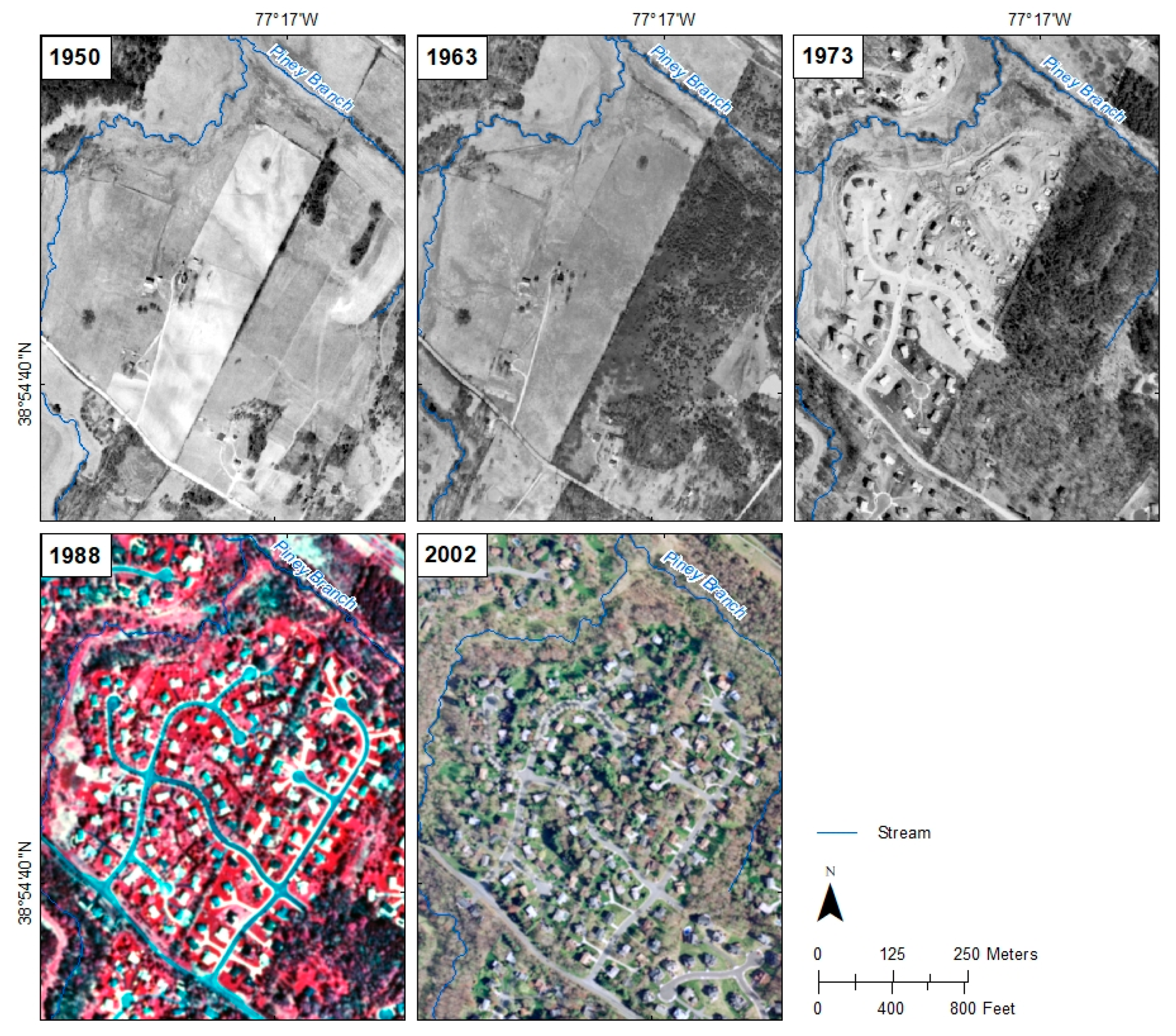
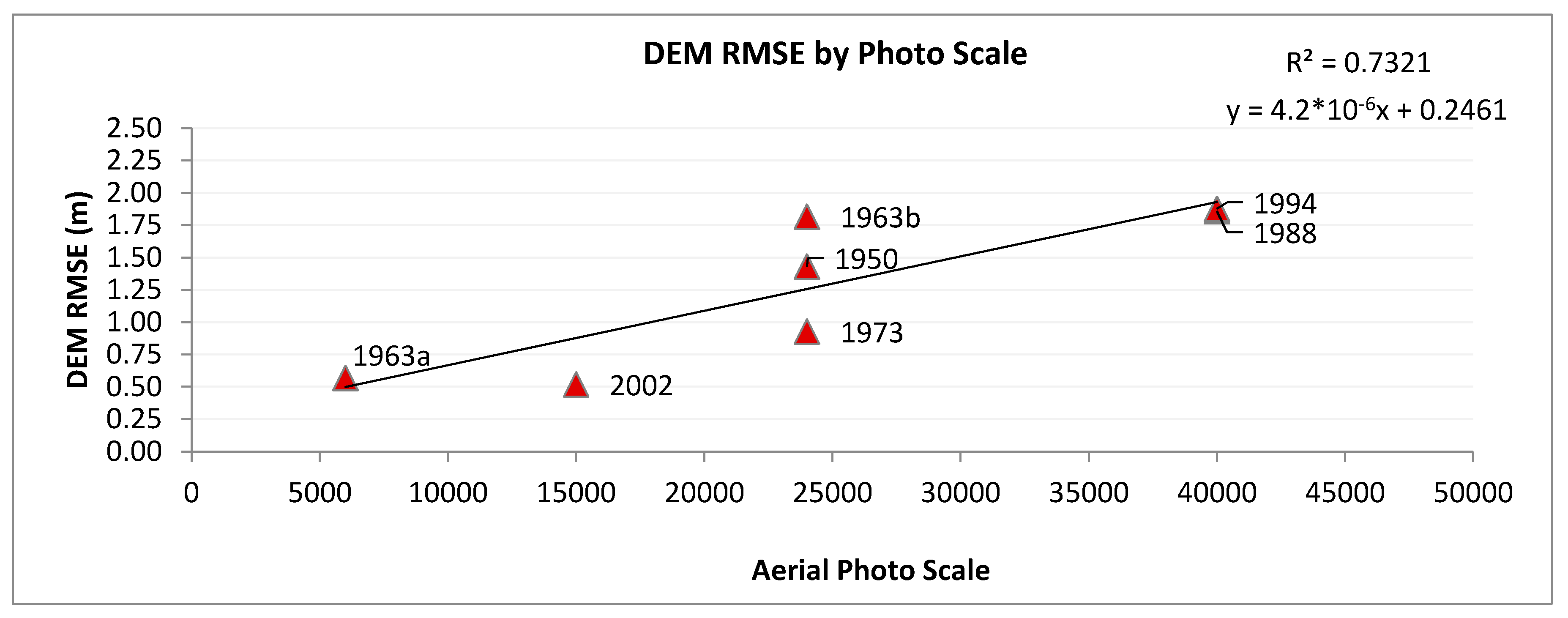
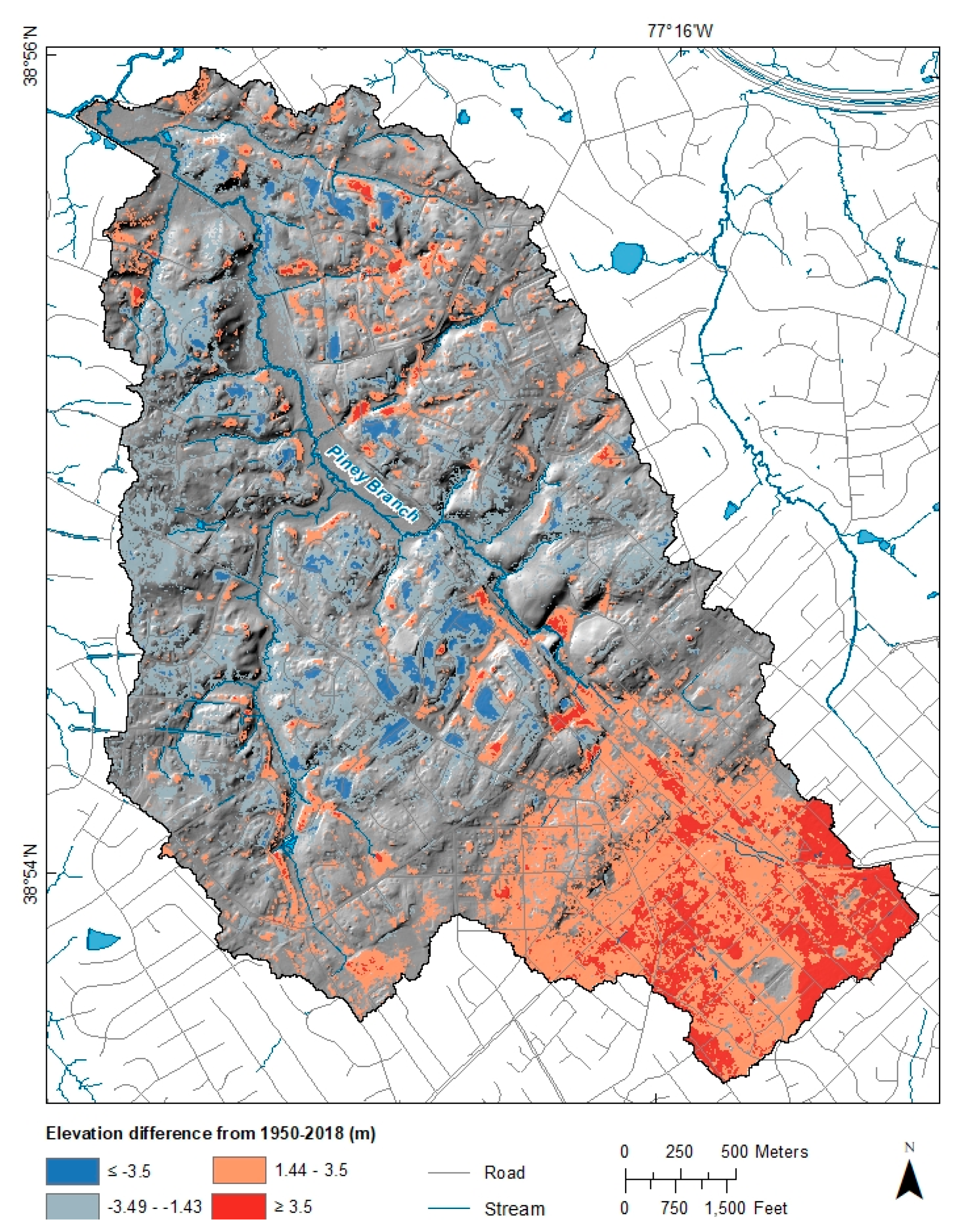
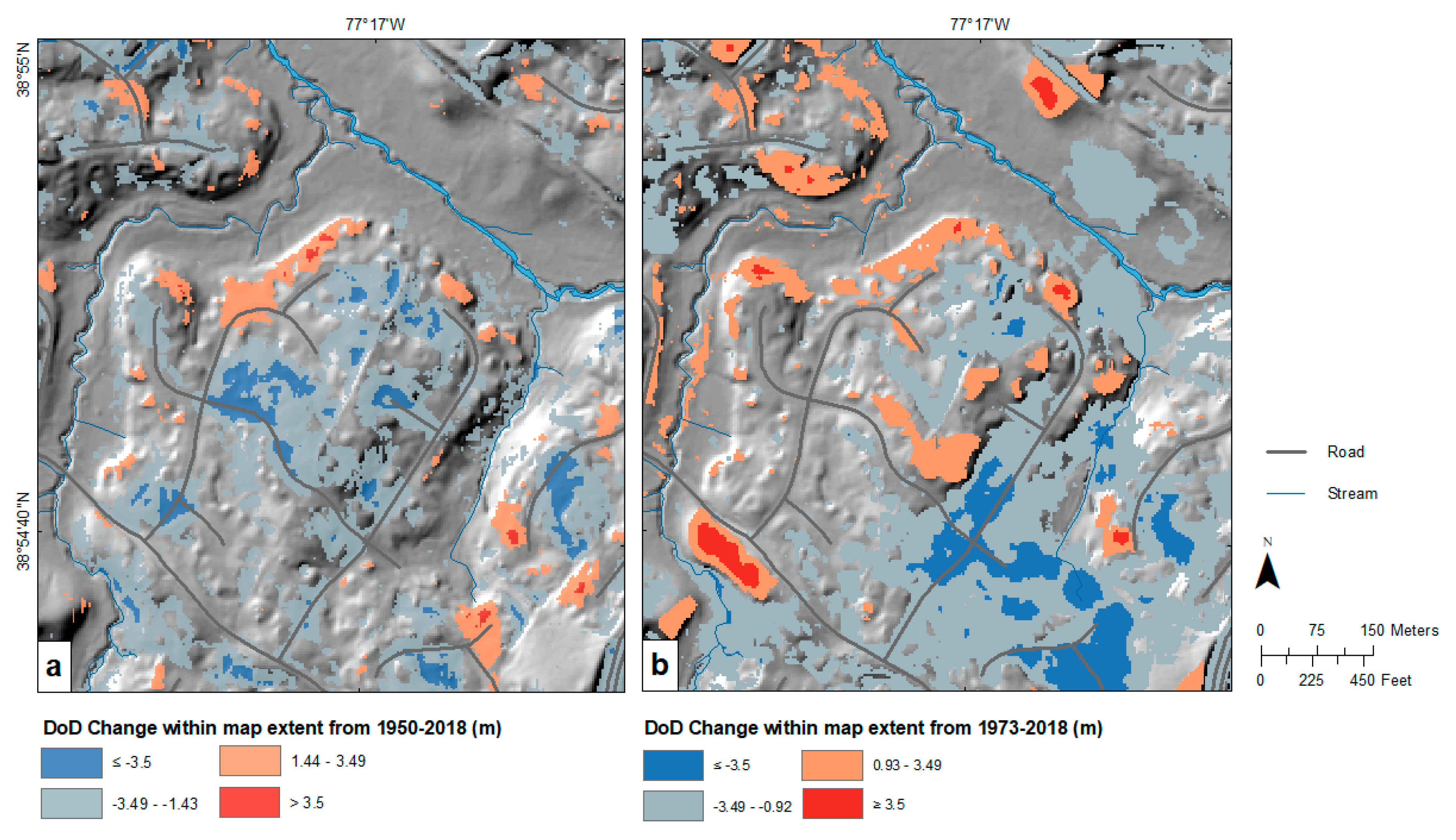
| Year | Horizontal Resolution (m) | Vertical Resolution (m) | Name | Used for |
|---|---|---|---|---|
| 2008 | 3m | 0.3 | LiDAR-based DEM collected by USGS for Washington DC Metro Area | Ground Control Point (GCP) elevation values, Independent Control Point (ICP) elevation values |
| 2012 | 3m | 0.19 | LiDAR-based DEM collected by FEMA | Bare earth DTM for comparison |
| 2018 | 1 m | 0.088 | VA Fairfax County | Topographic Change comparison |
| GCP ID | Easting (X) | Northing (Y) | GCP Elevation |
|---|---|---|---|
| 1 | 303,680.6271 | 4,308,232.6065 | 114.1401 |
| 2 | 301,027.8431 | 4,306,197.5232 | 126.4983 |
| 3 | 301,632.6882 | 4,30,9477.6943 | 89.9634 |
| 4 | 303,907.1570 | 4,313,620.5091 | 114.5788 |
| 5 | 305,415.1165 | 4,312,479.0262 | 114.0912 |
| 6 | 300,184.3822 | 4,311,806.1199 | 75.4243 |
| 7 | 306,952.8817 | 4,307,551.1839 | 140.7249 |
| 8 | 306,046.5920 | 4,307,541.1486 | 126.9768 |
| 9 | 297,523.1909 | 4,309,900.5517 | 102.3453 |
| 10 | 300,172.4621 | 4,305,943.5796 | 128.8150 |
| 11 | 301,921.8264 | 4,310,440.5494 | 91.1252 |
| Photo Scale | Acquisition Date | Extent of Stereo Coverage | Project | Flying Height (ft) | Focal Length (mm) | Image Type | Number Images |
|---|---|---|---|---|---|---|---|
| 1:6,000 | 1963 MAR 25 |  | VARK0 | 3,000 | 153.34 | B&W | 15 |
| 1:15,000 | 2002 APR 07 |  | WAS00 | 7,500 | 152.99 | Color | 8 |
| 1:24,000 | 1950 MAR 30 |  | KA000 | 12,000 | 155.07 | B&W | 6 |
| 1:24,000 | 1963 MAR 29 |  | VAQW0 | 12,000 | 153.34 | B&W | 5 |
| 1:24,000 | 1973 MAR 23 |  | VDGQ0 | 12,000 | 152.58 | B&W | 9 |
| 1:40,000 | 1988 APR 20 |  | NAPP | 20,000 | 152.82 | CIR | 4 |
| 1:40,000 | 1994 MAR 17 |  | NAPP 9422 | 20,000 | 153.14 | CIR | 4 |
| Year | Scale | Number of Photo Frames | Photo Resolution (m) | SfM Model RMSE | SfM Orthoimage Resolution (m) | SfM DEM Resolution (m) | Number of ICPs | DEM Vertical RMSE |
|---|---|---|---|---|---|---|---|---|
| 1950 | 24,000 | 6 | 0.60 | 0.710 | 0.59 | 1.17 | 32 | 1.430 |
| 1963a | 6000 | 15 | 0.15 | 0.469 | 0.15 | 0.30 | 13 * | 0.569 |
| 1963b | 24,000 | 5 | 0.60 | 1.310 | 0.61 | 1.22 | 28 | 1.816 |
| 1973 | 24,000 | 9 | 0.60 | 0.042 | 0.60 | 1.21 | 31 | 0.928 |
| 1988 | 40,000 | 4 | 1.00 | 1.943 | 1.02 | 2.04 | 32 | 1.859 |
| 1994 | 40,000 | 4 | 1.00 | 2.124 | 0.97 | 1.95 | 29 | 1.877 |
| 2002 | 15,000 | 8 | 0.38 | 0.021 | 0.37 | 0.74 | 15 * | 0.520 |
| DEM Comparison Dates | Temporal Interval (years) | RMSErecent | RMSEolder | Combined RMSE (m) | RSiQ (m) |
|---|---|---|---|---|---|
| 1963b-1950 | 13 | 1.81 | 1.430 | 3.240 | 2.31 |
| 1973-1963b | 10 | 0.92 | 1.810 | 2.730 | 2.03 |
| 1988-1973 | 15 | 1.85 | 0.920 | 2.770 | 2.07 |
| 1994-1988 | 6 | 1.87 | 1.850 | 3.720 | 2.63 |
| 2002-1994 | 6 | 0.52 | 1.870 | 2.390 | 1.94 |
| 1973-1950 | 23 | 0.92 | 1.430 | 2.350 | 1.70 |
| 1994-1973 | 21 | 1.87 | 1.810 | 3.680 | 2.60 |
| 2018-1994 | 24 | 0.088 | 1.870 | 1.958 | 1.87 |
| 2018-1973 | 45 | 0.088 | 0.920 | 1.008 | 0.92 |
| 2018-1963a | 55 | 0.088 | 0.569 | 0.657 | 0.58 |
| 2018-1950 | 68 | 0.088 | 1.430 | 1.518 | 1.43 |
© 2020 by the authors. Licensee MDPI, Basel, Switzerland. This article is an open access article distributed under the terms and conditions of the Creative Commons Attribution (CC BY) license (http://creativecommons.org/licenses/by/4.0/).
Share and Cite
Chirico, P.; DeWitt, J.; Bergstresser, S. Evaluating Elevation Change Thresholds between Structure-from-Motion DEMs Derived from Historical Aerial Photos and 3DEP LiDAR Data. Remote Sens. 2020, 12, 1625. https://doi.org/10.3390/rs12101625
Chirico P, DeWitt J, Bergstresser S. Evaluating Elevation Change Thresholds between Structure-from-Motion DEMs Derived from Historical Aerial Photos and 3DEP LiDAR Data. Remote Sensing. 2020; 12(10):1625. https://doi.org/10.3390/rs12101625
Chicago/Turabian StyleChirico, Peter, Jessica DeWitt, and Sarah Bergstresser. 2020. "Evaluating Elevation Change Thresholds between Structure-from-Motion DEMs Derived from Historical Aerial Photos and 3DEP LiDAR Data" Remote Sensing 12, no. 10: 1625. https://doi.org/10.3390/rs12101625
APA StyleChirico, P., DeWitt, J., & Bergstresser, S. (2020). Evaluating Elevation Change Thresholds between Structure-from-Motion DEMs Derived from Historical Aerial Photos and 3DEP LiDAR Data. Remote Sensing, 12(10), 1625. https://doi.org/10.3390/rs12101625





